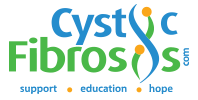Ten Hurdles to Cystic Fibrosis Patient Adherence
By on Jun 4, 2012
(source: EyeforPharma Blog)
There are many factors which can influence the level of patient adherence in any given treatment, Jeanne Barnett looks at how social platforms can provide the answers and presents her findings.
You may already be aware of the great success of the Khan Academy for educating students with self-paced online learning that can be accessed anywhere and anytime. Their mission is “A free world-class education to anyone anywhere.”
At CysticFibrosis.com, we have offered a free, world-class education on the optimal management of cystic fibrosis since 1996.
Patients with chronic diseases face multiple barriers to adherence with regard to treatment regimens. On our social health community, CysticFibrosis.com, we have observed thousands of conversations about adherence and conducted surveys on this subject. Our Health Opinion Leaders (HOLs) identified the following particular adherence issues that we feel apply to other chronic diseases as well.
1. Time Management: A recent poll on our site identified time management as the #1 barrier to adherence. The CF treatment regimen can take up to five hours a day, and other disease care is similarly time-consuming. Many patients are choosing between doing all their treatments or sleeping, working, going to school…etc.
2. Tracking and Scheduling: Patients often have trouble keeping track of medications and treatments on a daily basis, as well as ensuring there is no gap between refills or loss of functionality of equipment in the long term.
3. Comprehension: Doctors and other medical professionals often have limited time in which to convey treatment information, and patients and caregivers take away a only portion of the instructions or misunderstand them.
4. Lack of Knowledge: Patients are often unaware of all the treatments available to them, and they are often confused about the method of administration of medications and the maintenance of durable medical equipment.
5. Cost of Treatments and Equipment: Patients sometimes lack sufficient finances to cover co-pays for expensive medications, supplements, food and other helpful resources such as exercise equipment or gym memberships.
6. Distance to Appropriate Doctors and Centers: Patients sometimes have to drive 1-3 hours to be treated at a clinic, and they postpone check-ups and admissions due to scheduling or transportation issues.
7. Social Factors: Patients often face awkward or discriminatory social situations with regard to doing treatments in public, the workplace or even with friends. Additionally, CF patients cannot socialize with one another due to the risk of cross-contamination.
8. Mental Health Factors: Stress and depression are more than occasionally cited as reasons patients do not complete their treatments. Depressed or stressed patients may lack motivation or have trouble focusing on the tasks needed to adhere to a complicated and time-consuming treatment regimen.
9. Unsafe Health Facilities: Patients are often hesitant to seek treatment, whether routine or in an acute situation, for fear of acquiring multi-resistant strains of bacteria.
10. Perceived Inefficacy of Treatments: Patients are often misinformed as to when they will see results, or they draw unfounded conclusions regarding positive or negative effects of the medication/treatments. We’ve analyzed the barriers to adherence listed above, and our nonprofit organization, CFTechnology, is striving to take the next step with that knowledge. We are organizing and disseminating adherence knowledge and techniques in a broader and more accessible manner than even our message boards. We are aiming to develop technology that promotes adherence along two interwoven fronts: education and motivation.
Education
- Informational apps on mobile devices to educate patients and caregivers, with “teach the teacher” programs for patients, parents and relatives, education faculty, and healthcare providers to advance understanding of the disease pathology and its comorbidities, as well as comprehension of the importance of adherence to care routines.
- Web-based multimedia content, such as video tutorials and podcasts, educating on subjects such as proper airway clearance technique, maintenance of durable medical equipment, medication storage and delivery, tips for extenuating circumstances (vacations, natural disasters, etc.), and disease-specific nutrition and exercise recommendations.
Motivation
- Interactive applications to keep patients involved in their care and motivated to complete treatment regimens.
- Games and picture-based scheduling applications geared to children to encourage self-monitoring and adherence in early childhood.
- Information and applications focused on the time of transition from child- to adulthood, a time when patients are most likely to be non-compliant.
The e-patient model is here to stay, and the wave of the future is adopting the technology that is available to us for education and motivation—the keys to patient adherence.




